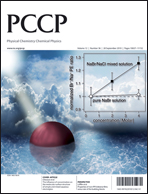Hindered torsional motion in a molecule such as HSOH leads to tunnelling splittings. Lying between the simpler limiting cases of strongly hindered torsion (the “we can simply neglect the tunnelling” limit) and that of free internal rotation (the “tunnelling pair of levels are just different vibrational states” limit) HSOH is particularly challenging due to strong and inherent torsion–rotation coupling. The low symmetry due to the different terminal moieties, SH and OH, further enriches the energy level pattern by allowing a systematic mixing within each quadruplet of torsion- and asymmetry-doubled levels. This mixing, which varies in a systematic manner with angular momentum quantum numbers, can reach 50% and is in addition to the mass-dependent and quasicyclic variation of the tunnelling splittings. We show that a carefully implemented reduced-dimension model, the Generalised SemiRigid Bender (GSRB), combined with a few modest ab initio calculations, is sufficient to account for the bulk of these physical effects. We also point out the reversal of energy pairing of torsional levels with increased energy. That is, at low torsional energy the lowest of the torsional level pair is the symmetric level while at high torsional energy it is the antisymmetric level which is the lowest. Finally, we present a purely empirical determination of the tunnelling splittings for K = 0, 1, 3, 4, and 5.

You have access to this article
 Please wait while we load your content...
Something went wrong. Try again?
Please wait while we load your content...
Something went wrong. Try again?


 Please wait while we load your content...
Please wait while we load your content...